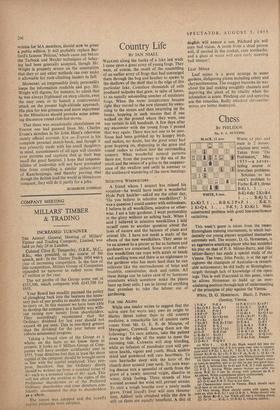Chess
BY PHILIDOR
No. 9..1. BUNTING
WHITE 10 play and mate in 2 moves: solution next week. Taken from 'The Problemist,' May 1955—a never- I. failing source of first-class problems. Solution to last week's problem by Fuchs: K-B I, threat
B-Kt 1. 1 . . .
WHITE, 8 men. B-Kt 4 ch; 2 Kt-B4.
I . . . R-Kt 3; 2 Kt-Kt 7. 1 . . . R-B 4; 2 P x P. 1 . . . 5; 2 Kt-Q 4. 1 . . . P-K 5; 2 Kt-Kt 5. Well- constructed problem with good line-interference variations.
This week's game is taken from the recent Birmingham training tournament, in which inci- dentally our young players acquitted themselves extremely well. The winner, D. G. Horseman, is an aggressive attacking player who has modelled his play on that of P. S. Milner-Barry, and (like Milner-Barry) has made a special study of the Vienna. The loser, John Purdy, is at the age of eighteen the champion of Australia—a remark- able achievement: he did badly at Birmingham, largely through lack of knowledge of the open- ings. This is well illustrated in this game, where he allows Horseman to build up an over- whelming position through lack of understanding of the principles of play against the Vienna.
White, D. G. HORSEMAN. Black, J. PURDY.
Opening, Vienna.
1 P-K 4 P-K 4 14 P-K 6 l(f> KfxP? 2 Kt-Q B 3 Kt-K B 3 15 Kt-K 5 Q-11 2 3 P-B 4 P-Q 4 16 BxB I3PxB
4 BPxP KtxP 17 0-Kt 4 Kt-Q 1 (a) 5P-Q3 Kt x Kt (a) 18 KtxKtPl PxKt 6 PxKt Kt-B 3 19 Q x P ch K-Q 2 7 Kt-B 3 B-K Kt 5 ?(b) 20 B-B 4 Q-B 1
fi P 4 B K 2 21 Q R-K I P-B 4
9 B- 3 Q-027(c) 22 Rxfich KxR 10 0- B-R 4 (d) 23 R-K 1 ch Kt-K 3 II R-Kt 11 Kt-Q I 24 Q x P ch K-Q I (0 12 Q-K 1 (e) B-Kt 3 25 II-Kt 3 ch Resigns
13 Q-Kt 3 P-Q B 3
(a) With 5 . . Q-R 5 ch; Black would fall into the Wurzburger trap—but it is not quite clear who is trapped, since after 6 P-Kt 3, Kt x P; 7 Kt-B 3, Q- R 4; 8 Kt x P! (threat Kt-B 4), Kt x R; 9 Kt x P ch, K-Q I. 10 Kt x there are chances for both sides, with White probably better. 16) Quite wrong idea. Black must break White's centre as soon as possible, and to do this he has two good lineg: (I) 2 followed by 0-0 and P-K II 3 with equality, (2) P-Q5, leaving White centre broken up—after this move, B-K Kt 5 can be strong with pressure on K P. As played, White consolidates centre undisturbed.
(c) Better P-K B 3, followed by 0-0. (d) 0-0 and P-B 31 Text is too slow.
(e) Characteristic move in Vienna. Black should reply 0-0 here or on next move. (f) Very strong. Black should retake with queen, but even so, after B-K Kt 5 and Q R-K I, White should win. (0 Better Kt-B 1, but White still has a winning attack.
(k) Or 24 , K-K ; 25 B-Kt 5, winning quickly.


































 Previous page
Previous page